Further education and skills inspections and outcomes as at 31 August 2018: main findings
Updated 21 September 2020
Applies to England
This release contains:
- provisional data for the most recent inspections and outcomes as at 31 August 2018
- provisional data for inspections conducted between 1 September 2017 and 31 August 2018
- revised data for inspections conducted between 1 September 2017 and 28 February 2018
The number of further education and skills providers has increased by 44%.
The apprenticeship funding reforms introduced in April 2017 have increased the number of further education and skills providers. As at 31 August 2018 there were 1,682 open and funded providers, an increase of 514 since 31 August 2017.
New provider monitoring visits found 82% of providers to be making at least reasonable progress.
Since their introduction in February 2018, 61 new provider monitoring visits have been carried out. From these visits, 82% of providers were found to be making at least reasonable progress across all judgements.
The proportion of general further education colleges judged good or outstanding has increased by 9 percentage points.
The proportion of general further education colleges judged good or outstanding at their most recent inspection was 76% as at 31 August 2018. This is 9 percentage points higher than as at 31 August 2017 (see Figure 1).
Figure 1: Proportion of general further education colleges judged good or outstanding for overall effectiveness at their most recent inspection, over time
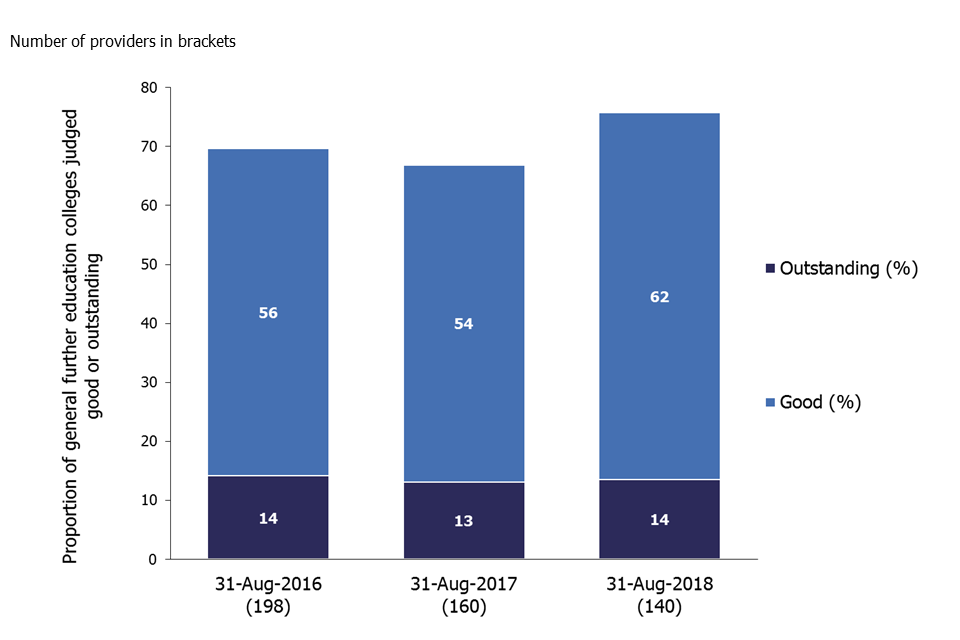
1. Introduction
1.1 In-year inspection outcomes
Between 1 September 2017 and 31 August 2018, 329 further education and skills providers were inspected. These included 89 colleges, 115 independent learning providers (including employer providers), 75 community learning and skills providers and 50 inspections of other further education and skills providers. Ofsted also contributed to 41 prison and young offender institution inspections, where the reports were published by Her Majesty’s Inspectorate of Prisons between 1 September 2017 and 31 August 2018.
The 329 further education and skills inspections consisted of 187 full inspections and 142 short inspections (including those that converted to full inspections). These inspections can be broken down into the following categories:
- 142 short inspections of previously good providers (including those that converted to a full inspection)
- 92 routine full inspections of providers previously judged requires improvement or inadequate
- 50 risk-assessed full inspections of previously good or outstanding providers
- 40 full inspections of providers that were inspected for the first time
- 5 full inspections of outstanding providers that were subject to routine inspection [footnote 1]
Between 1 September 2017 and 31 August 2018 the proportion of providers judged good or outstanding was 70%, 7 percentage points higher than in the last reporting year (1 September 2016 to 31 August 2017).
Figure 2: Further education and skills providers’ full and short inspection outcomes, by reporting year
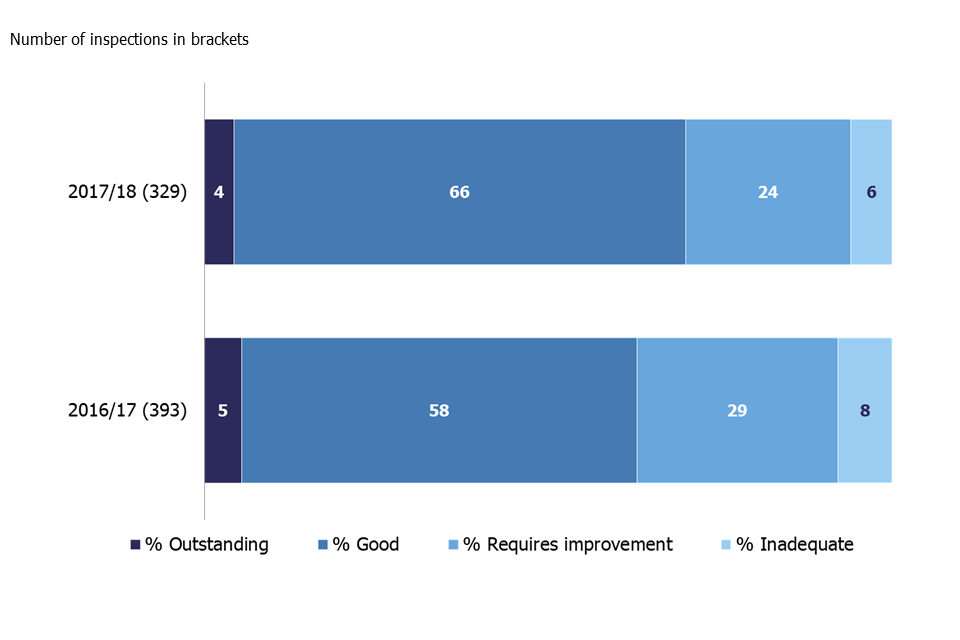
There are 2 contributing factors that have led to the higher proportion of providers judged good or outstanding this reporting year:
- a higher proportion of short inspections of previously good providers being carried out
- a higher proportion of providers previously judged requires improvement improving at inspection this year
This year, as the first cycle of short inspections has ended (introduced on 1 September 2015), a much higher proportion of short inspections have been carried out compared with last year.
Figure 3: Proportion of providers selected for inspection, by inspection type and reporting year
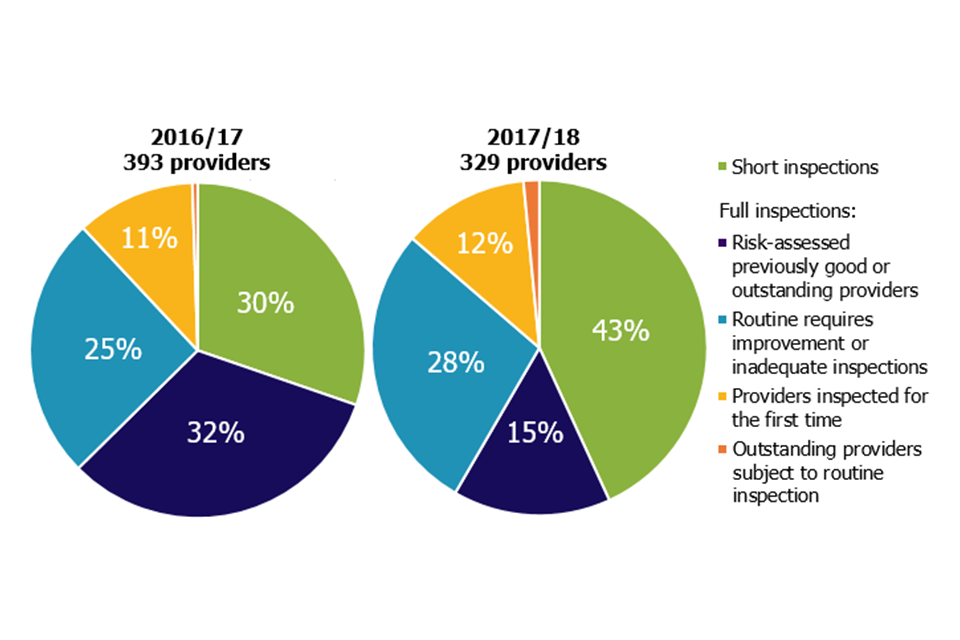
As well as carrying out an increased proportion of short inspections, a higher proportion of these inspections resulted in the provider remaining good compared with last year. Of the 142 short inspections, 93% of providers remained good or improved to outstanding, compared with 89% in the last reporting year.
Conversely there was a smaller proportion of risk-assessed full inspections of providers previously judged good or outstanding. Although the outcomes of risk-assessed full inspections carried out this reporting year were similar to last year, the balance of risk-assessed full inspections versus short inspections was tipped towards short inspections.
There was a small increase in the proportion of routine full inspections of providers that were previously judged requires improvement. However, outcomes from these inspections were higher this reporting year, with 66% of the providers improving to be good compared with 56% last reporting year.
1.2 In-year safeguarding judgements
Of the 329 providers inspected between 1 September 2017 and 31 August 2018, the overwhelming majority (319) had effective safeguarding arrangements in place for learners. Ten providers were judged not to have effective safeguarding arrangements in place: 8 independent learning providers (including employer providers), 1 local authority provider and 1 specialist further education college.
In the providers that did not have effective safeguarding arrangements in place, inspectors found:
- a failure to implement safeguarding policies and procedures to protect learners
- leaders and managers had been slow in implementing the ‘Prevent’ duty
- learners were not equipped with the necessary knowledge to ensure they could keep themselves safe
- a failure to ensure adequate risk assessments had been carried out
1.3 In-year monitoring visit outcomes
This year, Ofsted introduced new provider monitoring visits for providers that had not yet been inspected and that were receiving funding through the apprenticeship levy. Due to the large growth in the number of providers entering the market, we visited a sample of providers to find out if there was a potential risk to the quality of apprenticeships.
Between February 2018 (when they were introduced) and 31 August 2018, 61 new provider monitoring visits were carried out. Nine were to employer providers and 52 to independent learning providers. Ofsted judged 82% of the providers to be making at least reasonable progress in all areas.
Table 1: New provider monitoring visit outcomes, between 1 February 2018 and 31 August 2018
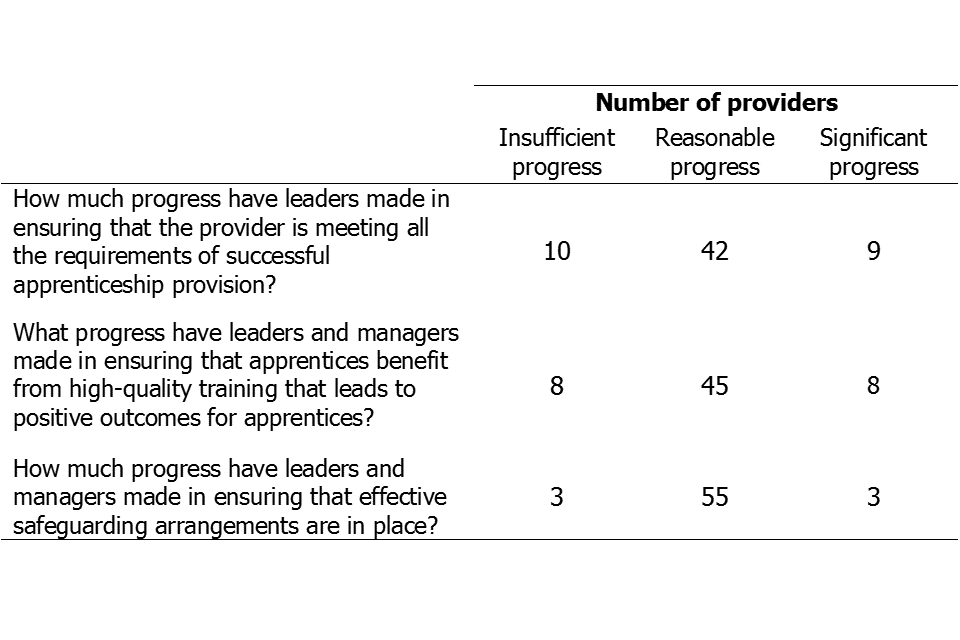
Where a provider is judged to have made insufficient progress with respect to safeguarding, they will normally receive a further monitoring visit to review their safeguarding arrangements within 4 months of the initial monitoring visit. We revisited 1 provider during this reporting year and at that second visit judged the provider to be making significant progress towards safeguarding its apprentices. The other 2 will be revisited during the next reporting period.
1.4 Most recent inspection outcomes
As at 31 August 2018, there were 1,682 open and funded further education and skills providers recorded on the Ofsted systems, an increase of 44% compared with 31 August 2017. This increase was largely as a result of the apprenticeship funding reforms introduced in April 2017, which significantly changed the further education and skills landscape.
Each year, the number of providers subject to an inspection will change as contracts to provide education, training and apprenticeships are won and lost. Historically, at any given point in the year, we will have inspected the quality of education and training in around 90% of the providers. The remaining providers falling within our commitment to inspect new providers within their first 3 years of operation.
Many of these additional providers will not have been inspected by Ofsted in the past. As a result, the proportion of providers that had been inspected dropped by 26 percentage points, from 88% as at 31 August 2017 to 62% as at 31 August 2018.
Of the 1,040 providers that had been inspected, the overall proportion of providers judged good or outstanding as at 31 August 2018 was 81%, 1 percentage point higher than as at 31 August 2017.
Figure 4: Overall effectiveness of further education (FE) and skills providers at their most recent inspection, as at 31 August 2018
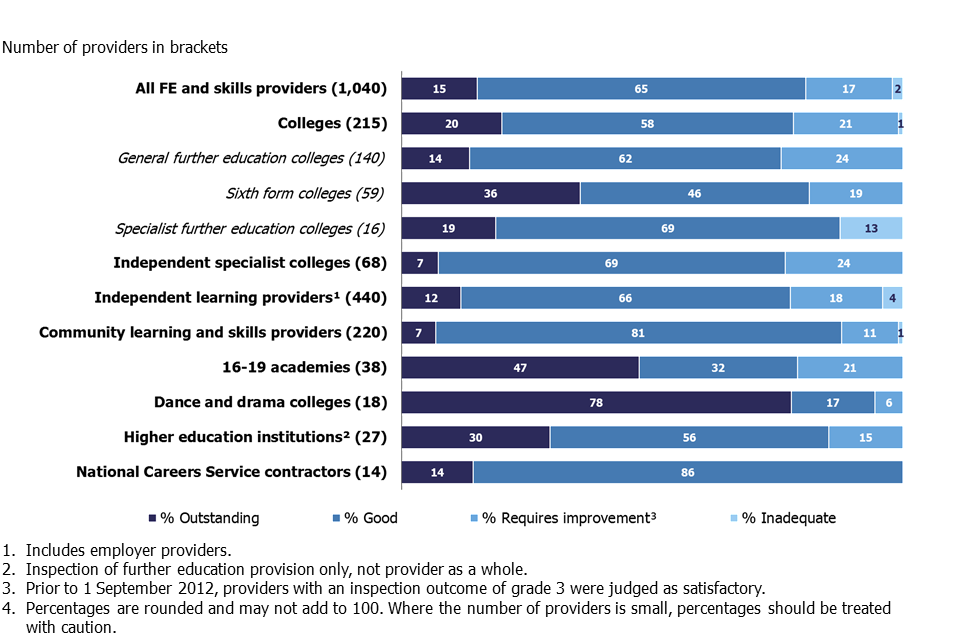
The proportion of providers judged good or outstanding at their most recent inspection increased in 2 out of the 3 largest provider groups. General further education colleges had the largest increase at 9 percentage points. Followed by community learning and skills providers at 5 percentage points. These increases were balanced out by the continued decline in the proportion of independent learning providers (including employer providers) judged good or outstanding. This meant that the overall proportion judged good or outstanding increased by 1 percentage point.
2. Main findings
2.1 General further education colleges
Between 1 September 2017 and 31 August 2018, the number of general further education (FE) colleges continued to decline, from 189 to 178. This reduction was the result of general FE colleges merging with other providers. Following these mergers, 11 general FE colleges are now no longer reported on separately. Having been subject to mergers, another 11 general FE colleges will now be treated as new providers, not carrying forward their previous inspection judgement. The most recent inspection outcomes for the 22 general FE colleges involved were:
- 13 colleges judged good
- 6 colleges judged requires improvement
- 3 colleges judged inadequate
As at 31 August 2018, 38 of the 178 general FE colleges did not have an overall effectiveness grade: 1 new college awaiting its first full inspection and 37 colleges that had formed through a merger. As set out in our inspection handbook, new providers will normally be inspected within 3 years. Where colleges that are judged requires improvement or inadequate merge we continue to engage with them through support and challenge or monitoring visits. All colleges that have formed through a merger will be inspected within a maximum of 3 years, and will also receive a monitoring visit prior to this inspection.
Between 1 September 2017 and 31 August 2018, 64 general FE colleges were inspected. These inspections comprised of 50 full inspections and 14 short inspections (including 1 that converted to a full inspection). The overall proportion of general FE colleges judged good or outstanding during this reporting year was 69%, 22 percentage points higher than last year.
Figure 5: General further education college full and short inspection outcomes, by reporting year
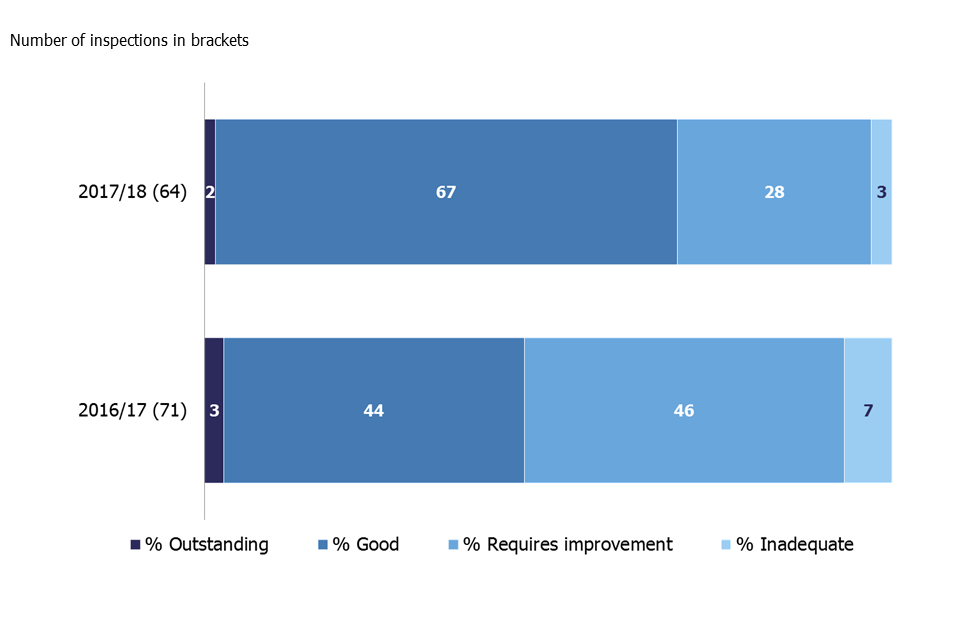
The higher proportion of general FE colleges judged to be good this year is largely the result of colleges that previously required improvement or were inadequate improving to good. Between 1 September 2017 and 31 August 2018, 19 out of 29 general FE colleges that previously required improvement or were inadequate improved to good. During the previous reporting year, 9 out of 29 general FE colleges improved to be good.
Table 2: General further education college inspection outcomes between 1 September 2017 and 31 August 2018, by previous overall effectiveness and type of inspection

The inspections carried out this year have had a positive effect on the most recent inspection outcomes. As at 31 August 2018, the proportion of general FE colleges judged good or outstanding at their most recent inspection was 76%, 9 percentage points higher than the 67% as at 31 August 2017. This increase was largely the result of a higher proportion of general FE colleges improving to be good at inspection this year.
As at 31 August 2018, there were no general FE colleges judged to be inadequate. This is 4 less than as at 31 August 2017. One of those 4 improved to good at inspection this reporting year and the other 3 have been subject to a merger.
2.2 Sixth-form colleges
Between 1 September 2017 and 31 August 2018, the number of sixth-form colleges reduced by 18, from 79 to 61. This decrease is the result of 13 sixth-form colleges converting to become 16 to 19 academies and 5 merging with other providers.
Eleven of the 13 sixth-form colleges that converted to become 16 to 19 academies were judged good or outstanding at their most recent inspection. Four sixth-form colleges merged with general FE colleges and 1 with another sixth-form college. Of those sixth-form colleges that merged 4 were judged good at their most recent inspection and 1 requires improvement.
As at 31 August 2018, all but 2 of the 61 sixth-form colleges had been inspected. The remaining 2 have been subject to a merger and will be inspected within 3 years. Sixth-form colleges that have merged will no longer be reported on separately.
Between 1 September 2017 and 31 August 2018, 19 sixth-form colleges were inspected. There were 12 full inspections and 7 short inspections (1 of which converted to a full inspection). Thirteen out of the 19 were judged good or outstanding.
Overall, the proportion of sixth-form colleges judged good or outstanding at their most recent inspection was 81% as at 31 August 2018. This is a slight increase (0.8 percentage points) compared with as at 31 August 2017.
2.3 16 to 19 academies
As at 31 August 2018, there were 46 16 to 19 academies, 15 more than as at 31 August 2017. This increase was largely the result of 13 sixth-form colleges converting to become 16 to 19 academies. There was also a net increase of 2 free schools. As at 31 August 2018, 83% of the 16 to 19 academies had been inspected. There were 8 16 to 19 academies awaiting their first full inspection.[footnote 2]
Between 1 September 2017 and 31 August 2018, 9 16 to 19 academies were inspected. There were 6 full inspections, of which 4 were judged to be requires improvement, 1 good and 1 outstanding. There were also 3 short inspections, 1 remained good and 2 converted and improved to outstanding.
As at 31 August 2018, the proportion of 16 to 19 academies judged good or outstanding at their most recent inspection was 79%, 6 percentage points higher than as at 31 August 2017. Much of this increase can be attributed to sixth-form colleges that have converted to become 16 to 19 academies since 31 August 2017 and retained their latest inspection outcome.
2.4 Independent learning providers (including employer providers)
Between 1 September 2017 and 31 August 2018, the number of open and funded independent learning providers (including employer providers) more than doubled, increasing from 491 to 986. This is mainly as a result of the apprenticeship funding reforms introduced in April 2017. This reduced the proportion of providers that had been inspected from 82% as at 31 August 2017 to 45% as at 31 August 2018.
Between 1 September 2017 and 31 August 2018, 102 independent learning providers and 13 employer providers were inspected. In total there were 62 full inspections and 53 short inspections (including those that converted to full inspections).
Overall 63% of independent learning providers (including employer providers) were judged good or outstanding during this reporting year, 6 percentage points higher than during the last reporting year. This is largely caused by an increased proportion of inspections being short inspections of previously good providers, of which more remained good.
Around two thirds of the providers that had not previously been inspected were judged requires improvement or inadequate at inspection this year. This is a similar proportion to last year.
Table 3: Independent learning providers (including employer providers) inspection outcomes between 1 September 2017 and 31 August 2018, by previous overall effectiveness and type of inspection
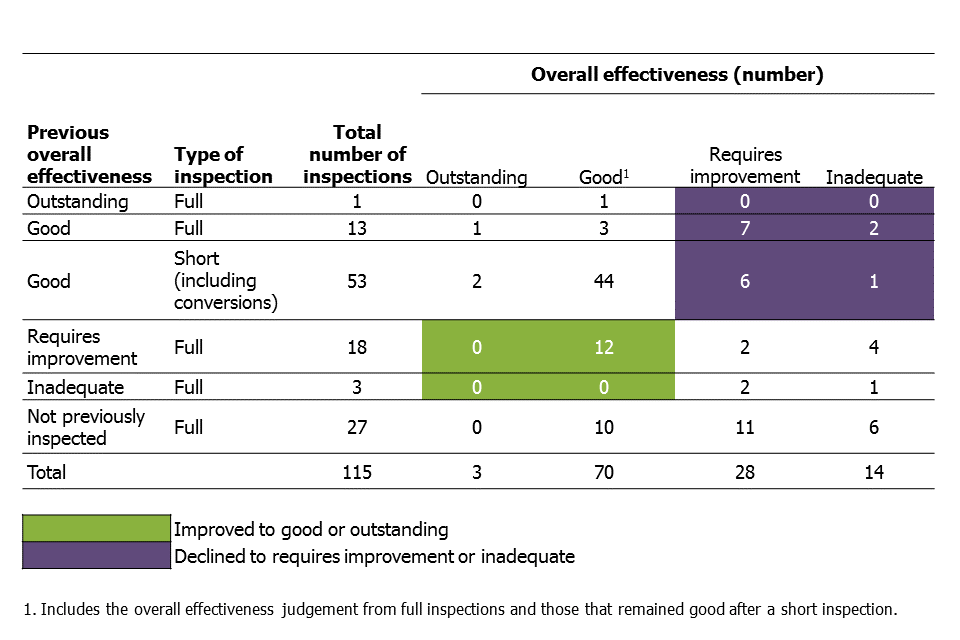
The in-year outcomes had a negative effect on the proportion of providers judged good or outstanding at their most recent inspection. Independent learning providers declined by 3 percentage points and employer providers by 1 percentage point. Overall, the proportion of independent learning providers (including employer providers) judged good or outstanding declined from 80% on 31 August 2017 to 78% on 31 August 2018.
This is the second year there has been a decline in the proportion of independent learning providers (including employer providers) judged good or outstanding.
Figure 6: Proportion of independent learning providers (including employer providers) judged good or outstanding for overall effectiveness at their most recent inspection, over time
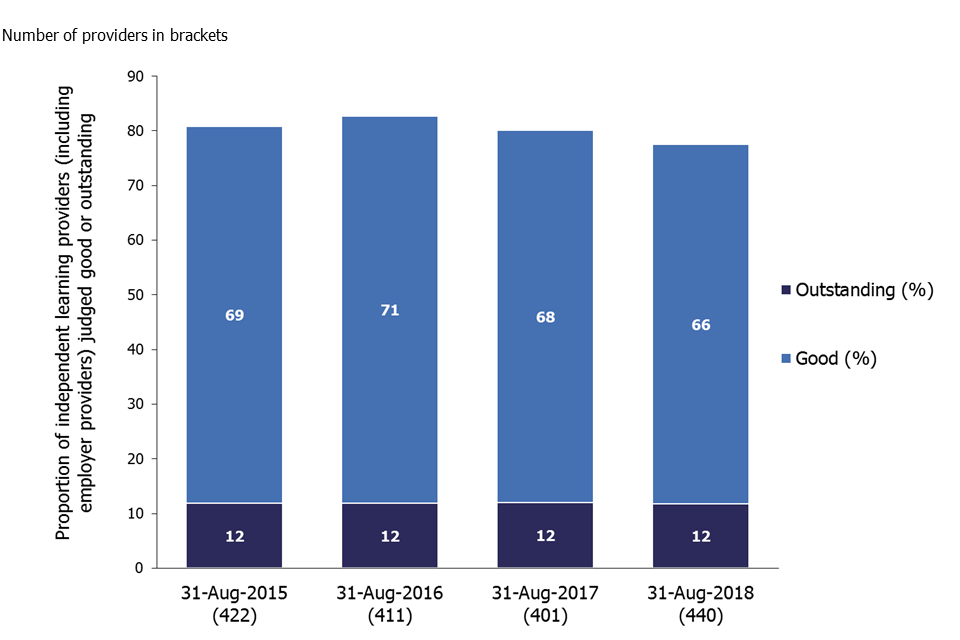
2.5 Community learning and skills providers
The number of open and funded community learning and skills providers decreased between 31 August 2017 and 31 August 2018, from 225 to 222. All but 2 of the providers had been inspected as at 31 August 2018, both of whom are awaiting their first full inspection.
Between 1 September 2017 and 31 August 2018, 75 community learning and skills providers were inspected. There were 34 full inspections and 41 short inspections (including 3 that converted to a full inspection). This year, more than double the number of community learning and skills providers improved to good (17) than declined from good to requires improvement or inadequate (8).
Table 4: Community learning and skills inspection outcomes between 1 September 2017 and 31 August 2018, by previous overall effectiveness and type of inspection
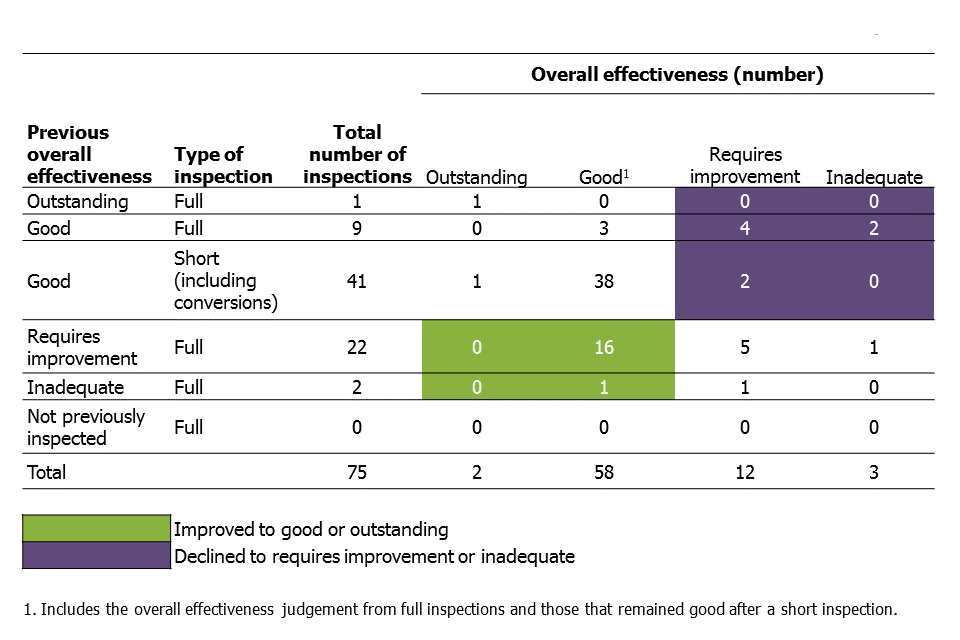
This increased the proportion of providers judged good or outstanding at their most recent inspection by 5 percentage points, from 83% on 31 August 2017 to 88% on 31 August 2018.
2.6 Prisons and young offender institutions
As at 31 August 2018, there were 114 prisons and young offender institutions (YOIs). All of the prisons and YOIs had been inspected.
Ofsted contributed to 41 prison and YOI inspections where the reports were published between 1 September 2017 and 31 August 2018. One prison and 1 YOI were inspected twice within the period. Overall, 16 of the prisons and YOIs were judged good for the overall effectiveness of education, skills and work (overall effectiveness)[footnote 3] , 20 requires improvement and 5 inadequate.
For 7 of the 41 prisons and YOIs, this was the first time they had received an overall effectiveness judgement since it was introduced in March 2014. Six out of the 7 were judged good and 1 was judged requires improvement.
Table 5: The overall effectiveness of education, skills and work in prisons and young offender institutions published between 1 September 2017 and 31 August 2018, by previous overall effectiveness grade
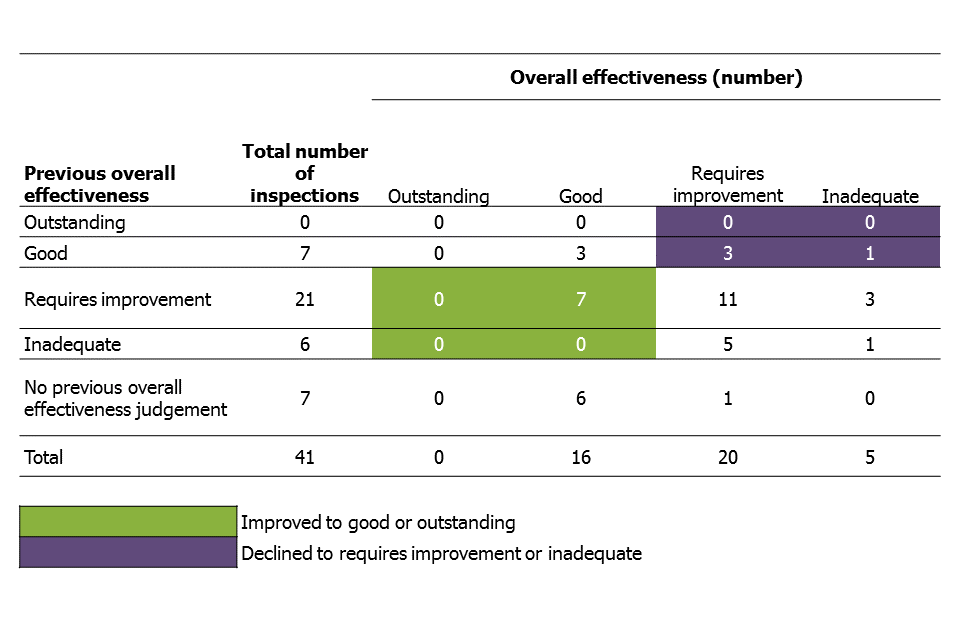
The in-year inspection outcomes had a positive effect on the most recent inspection outcomes for all prisons and YOIs. Overall, the proportion of prisons and YOIs judged good or outstanding for overall effectiveness at their most recent inspection increased by 6 percentage points: from 42% as at 31 August 2017 to 48% as at 31 August 2018.
Eleven prisons and YOIs inspected this year showed improvement; 5 improved from inadequate to requires improvement, with 1 YOI going on further to improve to good at their second inspection. However, 18 prisons and YOIs either remained requires improvement or inadequate this year, or declined to either grade. This includes 1 prison that was inspected twice this year and remained requires improvement at both inspections. This means that over half of the prisons and YOIs inspected this year did not improve.
2.7 Specialist further education colleges
Between 1 September 2017 and 31 August 2018, 6 specialist further education colleges were inspected. There were:
- 4 short inspections, 3 resulted in the college remaining good and 1 converting to a full inspection, at which the provider was judged outstanding
- 2 full inspections, at which 1 provider improved from requires improvement to good and 1 declined from requires improvement to inadequate
As at 31 August 2018, there were 16 open and funded specialist further education colleges, of which 14 were judged good or outstanding at their most recent inspection.
2.8 Independent specialist colleges
Between 1 September 2017 and 31 August 2018, 30 independent specialist colleges (ISCs) were inspected. There were 18 full inspections, at which half of the providers were judged good or outstanding. There were also 12 short inspections, 11 providers remained good and 1 inspection converted, at which the provider declined to requires improvement.
As at 31 August 2018, there were 80 open and funded ISCs, of which 68 had been inspected. Overall, 76% were judged good or outstanding. None were judged to be inadequate.
2.9 Higher education institutions
The number of higher education institutions (HEIs) included within these statistics has increased from 27 as at 31 August 2017, to 60 as at 31 August 2018. This increase has resulted from the Department for Education’s apprenticeship accountability statement in April 2017, which confirmed that Ofsted would inspect the quality of apprenticeships at levels 4 and 5. This policy continues to go through implementation, with further changes to the number of HEIs that require inspection expected. The overall number has also increased as a result of HEIs becoming newly funded for apprenticeship provision.
Between 1 September 2017 and 31 August 2018, the further education provision being delivered in 11 HEIs was inspected. There were 8 short inspections, which resulted in the HEIs remaining good. There were 3 full inspections of providers previously judged good or outstanding, of which 1 remained outstanding, 1 declined from outstanding to good and 1 declined from good to requires improvement.
As at 31 August 2018 the proportion of HEIs that were judged good or outstanding at their most recent inspection was 85%.
3. Revisions to previous release
3.1 In-year statistics
Alongside these Official Statistics a revised provider level dataset has been published, which includes inspections carried out between 1 September 2015 and 31 August 16 and inspections carried out between 1 September 2016 and 31 August 2017. This is due to 1 inspection report in each year being republished and now featuring a provision judgement for apprenticeships where these judgements were not previously included. These changes do not affect the overall messages of the main findings or tables and charts as previously reported.
Revisions to data in this publication are published in line with Ofsted’s revisions policy for official statistics.
4. Notes
4.1 Full inspections during this reporting year
Providers judged outstanding at their most recent inspection are not normally subject to routine inspection.[footnote 4] However, an outstanding provider may be risk assessed to receive a full inspection where its performance declines or there is another compelling reason, such as potential safeguarding issues. Providers judged good for overall effectiveness at their most recent inspection will usually be inspected within the 3 years from September 2015. This will normally be a short inspection (see below) but may be a risk-assessed full inspection where information suggests that this is the most appropriate course of action, for example if the provider’s performance has declined. A provider judged to require improvement at their most recent inspection will normally have a full re-inspection within 12 to 24 months of its previous inspection. Ofsted will monitor providers judged as inadequate and re-inspect them within 15 months of publication of their last full inspection report.[footnote 5]
4.2 Short inspections
Providers awarded a grade of good for overall effectiveness at their previous inspection will usually receive a short inspection.
A short inspection will determine whether the provider continues to provide a good standard of education/training for learners and whether safeguarding is effective.
A short inspection will not make individual graded judgements and will not change the provider’s overall effectiveness grade.
The lead inspector can choose to convert the short inspection to a full inspection where:
- there is insufficient evidence to confirm that the provider remains good
- there are concerns that there is evidence that the provider may no longer be good, which may include concerns about safeguarding
- if there is sufficient evidence of improved performance to suggest that the provider may be judged outstanding
If the inspection is converted to a full inspection, inspectors will make the full set of graded judgements. As a result of the converted inspection the provider could improve, decline or remain the same
The quality report for these official statistics contains an explanation of the methodology used and the relevant inspection frameworks, along with other useful information.
5. Glossary
General further education colleges
General further education colleges offer a range of education and training opportunities for learners aged from 14 years upwards, including adults. They include tertiary colleges, which specialise in land based education and training.
Sixth-form colleges
A sixth-form college is an educational institution where students aged 16 to 18 typically study for advanced school-level qualifications, such as A levels, or school-level qualifications such as GCSEs.
Specialist further education colleges
Specialist further education colleges are colleges who specialise in the provision of agricultural, horticultural or art, design and technology courses.
Independent specialist colleges
Independent specialist colleges provide education and training for students with complex learning difficulties and/or disabilities, whose learning needs cannot be met by their local college or provider.
Independent learning providers (including employer providers)
Independent learning providers are companies which provide government funded education. The category includes employer providers who only offer government funded training to their own employees.
Community learning and skills providers
Community learning and skills providers include local authorities, charities, voluntary, not for profit companies and community organisations, specialist designated institutions and community interest companies. Their provision is diverse in character and aims to meet the needs and interests of a wide range of communities. Courses include: those that lead to a qualification; programmes leading to qualifications whilst in employment (such as apprenticeships); provision for informal adult learning; and provision for social and personal development. Community learning and skills providers were previously categorised as adult and community learning providers.
16 to 19 academies
These are state-funded, non-fee-paying schools independent of local authorities which cater for pupils aged 16 to 19.
Dance and drama colleges
Colleges that specialises in delivering dance and drama courses.
Higher education institution
Where higher education institutions (such as universities) offer further education courses and/or level 4 or 5 apprenticeships, these are subject to inspection by Ofsted.
National Careers Service contractors
The National Careers Service provides information, advice and guidance for those aged 13 and over across England. The service is delivered in 12 geographical regions by area based prime contractors and a national contact centre by a national contractor.
Prisons and youth offender institutions
Ofsted undertakes inspections in prisons and youth offender institutions in partnership with Her Majesty’s Inspectorate of Prisons (HMIP). Ofsted inspectors evaluate the quality of education, skills and work in prisons and young offender institutions. Inspection reports can be found on the HMIP website.
6. Further information
6.1 Contact for comments or feedback
If you have any comments or feedback on this publication, please contact Sarah Pearce on 03000 130 632 or Sarah.Pearce@ofsted.gov.uk
6.2 Acknowledgements
Thanks to the following for their contribution to this statistical release: Stuart Lloyd, John Hadler and Kieran Rudge.
-
The following provider types remain subject to routine inspection when judged outstanding: higher education institutions offering further education, local authority providers, independent specialist colleges and dance and drama colleges. ↩
-
This includes 1 16 to 19 academy that was previously a school sixth-form. It was judged outstanding under the schools 2012 to 2015 inspection framework. It has yet to be inspected under the common inspection framework as a further education and skills provider. ↩
-
Previously known as ‘learning and skills and work activities’ ↩
-
The following types of provision are still subject to routine inspection when they have been judged outstanding: higher education institutions offering further education; local authority providers; independent specialist colleges; dance and drama colleges; and learning and skills provision in prisons. ↩
-
Full re-inspections or re-inspection monitoring visits may not happen in certain circumstances, for example where a provider’s funding contract has been terminated. ↩

